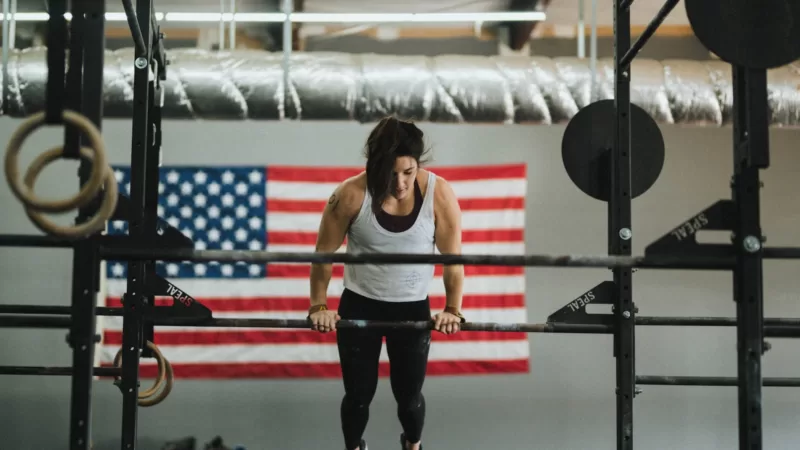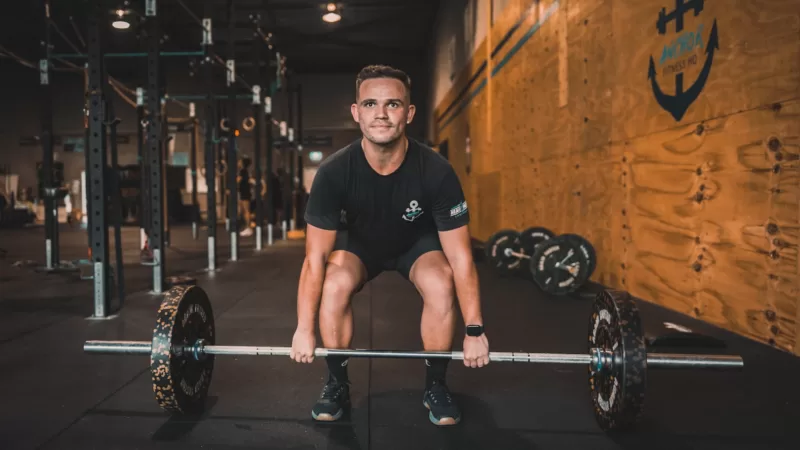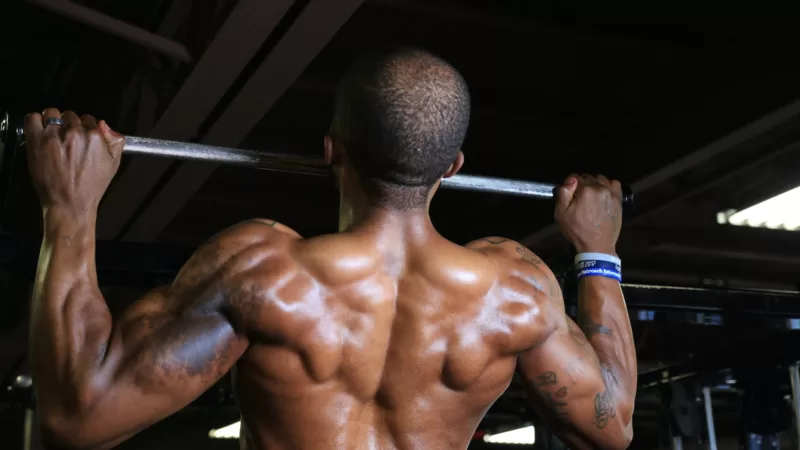What Are Thrusters in CrossFit? The Ultimate Guide

What Are Thrusters in CrossFit?
Key Takeaways
- The Mighty Thruster and Its Benefits: Thrusters, combining a front squat with an overhead press, are a potent compound movement in CrossFit training. This challenging exercise not only tests an individual’s strength, coordination, and endurance but also aids in building overall power and enhancing functional fitness. Thrusters effectively target triceps, hamstrings, and shoulders, thereby becoming a quintessential part of hero workouts. Whether you’re experienced or new to CrossFit, integrating thrusters can elevate your workout routine.
- Significance of Proper Technique in Thrusters: To reap the benefits of thrusters, maintaining correct technique is paramount. Starting with the correct stance—feet shoulder-width apart—and keeping the barbell resting on the front shoulders, it’s crucial to ensure a straight back and an upright torso throughout the exercise. Full hip extension and relying more on leg and hip strength rather than excessive upper body force are key to effective thrusters. Common mistakes, such as neglecting full hip extension, over-relying on upper body strength, or letting the back round, can compromise the efficacy of the movement and risk injury.
- Optimizing Thruster Performance and Avoiding Mistakes: For optimal results in CrossFit workouts using thrusters, athletes must be diligent in avoiding common technique errors. A stable foundation is a must, with feet shoulder-width apart. The core should always be engaged, and a controlled descent during the squat phase of the thruster ensures better muscle engagement. Breathing, too, plays a pivotal role: inhaling during the descent and exhaling during the ascent aids in stability and power. Consistent practice, feedback from skilled trainers, and a gradual increase in weights, while always emphasizing proper form, can aid in mastering the thruster and maximizing its benefits.
Are you ready to take your CrossFit workouts to the next level? Look no further than the mighty thruster! This popular compound movement combines a front squat with an overhead press, delivering a powerful punch that challenges your strength, coordination, and endurance. Whether you’re a seasoned CrossFitter or just starting out, incorporating thrusters into your routine can help build overall power and improve functional fitness. Thrusters are especially effective for targeting the triceps, hamstrings, and shoulders, making them an essential part of any hero wod.
Thrusters are not for the faint of heart in crossfit workouts. They require core strength and mental grit as you push through the burn in your hamstrings. Picture yourself gripping a barbell or kettlebell, squatting down low, then explosively driving up while simultaneously pressing the weight overhead. It’s an all-in-one exercise that targets multiple muscle groups, including the triceps, and gets your heart pumping in functional fitness.
In the world of CrossFit, front squats and overhead presses are staple compound exercises. Athletes at the CrossFit Games often tackle intense workouts featuring these challenging movements to target their triceps. So if you’re looking to amp up your training regimen and achieve new heights of fitness, grab some weights and get ready to crush those front squats and overhead presses!
Now let’s dive deeper into how CrossFit thrusters, front squats, and overhead presses can benefit athletes in functional fitness workouts and why they have become such beloved exercises in the CrossFit community.
Proper Technique and Common Mistakes in Thrusters
Starting with feet shoulder-width apart and the barbell resting on the front shoulders, thrusters are powerful full-body workouts used in CrossFit. To perform them effectively, it’s important to maintain an upright torso throughout the movement. Let’s explore some key points to keep in mind when executing squat workouts for arms with elbows.
- Upright Torso: Ensure that your chest is up and your back remains straight during the entire motion. Avoid excessive forward lean or rounding of the back, as this can lead to poor form and potential injury.
- Full Hip Extension: At the top of each rep, fully extend your hips by standing tall. This will engage your glutes and maximize power output. Neglecting this extension can limit the effectiveness of the exercise.
- Avoid Excessive Upper Body Strength: While upper body strength plays a role in thrusters, it should not be relied upon excessively. The primary driving force should come from your legs and hips. Using too much upper body strength can lead to fatigue more quickly and compromise proper technique.
Common mistakes often made during thruster movements include:
- Failing to achieve full hip extension at the top of each squat repetition with the barbell can negatively impact the shoulders during the thruster exercise.
- Relying too heavily on upper body strength instead of utilizing leg drive can hinder your progress in the squat and overhead press. Incorporating the thruster exercise into your routine can help engage both your shoulders and legs, ensuring a more balanced workout.
- Allowing excessive forward lean or rounding of the back during a squat can compromise form and put unnecessary strain on the shoulders. It is important to maintain proper alignment and engage the core when performing an overhead barbell squat.
- Starting with a wider stance or improper grip placement can affect the stability and balance of your squat. Make sure to position the barbell correctly on your shoulders and use the appropriate weight for your strength level.
By focusing on maintaining an upright torso and achieving full hip extension, you can safely and effectively perform heavy thrusters within your CrossFit workouts. Avoid excessive reliance on the shoulders and correct common mistakes to improve your squat technique and enhance your performance in hero wods. Adding weight to your thrusters will further challenge your strength and endurance.
Remember to always prioritize proper technique for optimal results while minimizing the risk of injury during intense workout sessions, especially when performing exercises like squats and crossfit thrusters.
Avoiding Common Mistakes in Thruster Technique
To maximize your performance and prevent injury in CrossFit workouts, it is crucial to avoid common mistakes in thruster technique. By focusing on proper form and execution of the squat movement, you can enhance your shoulder strength and achieve better results.
Here are the key takeaways to keep in mind:
- Maintain a solid foundation during your squat workout by ensuring your feet are shoulder-width apart and firmly planted on the ground. This will provide stability and allow for optimal power transfer during the crossfit thruster exercise.
- Engage your core during the squat workout to maintain stability and protect your lower back. Keep your abs tight and maintain a neutral spine position throughout the movement. This is important for performing exercises like the crossfit thruster.
- Control the descent: When lowering into the squat portion of the crossfit thruster workout, aim for a controlled movement rather than rushing through it. This allows for better muscle engagement and reduces the risk of injury to the bar.
- During the thruster exercise in your crossfit workout, remember to drive through your heels. This will help generate power and activate your glutes and hamstrings for a more explosive movement.
- Coordinate breathing with the thruster exercise movement: Inhale deeply during the descent into the crossfit thruster squat, then exhale forcefully as you drive up from the bottom position. Proper breathing technique enhances stability and provides additional power output during the workout.
By implementing these tips into your thruster workout technique, you can optimize performance while minimizing potential mistakes that may hinder progress or lead to injuries.
Remember to practice crossfit movements regularly, seek guidance from qualified coaches or trainers if needed, and gradually increase weights as you improve. With consistent effort and attention to detail, you’ll be able to perform thrusters efficiently while reaping their full benefits in a crossfit workout of the day (WOD).
Keep pushing yourself towards new goals in the CrossFit movement, stay motivated, and enjoy all that the thruster exercise, WOD, and bar have to offer!
FAQs
Q1: How do I know if I’m performing thrusters correctly?
A1: Pay attention to maintaining proper form during the crossfit thruster movement. Keep your feet shoulder-width apart, engage your core, and drive through your heels. Seek feedback from a qualified coach or trainer for correct technique in the bar WOD.
Q2: Can thrusters help me build muscle?
A2: Yes! Crossfit thrusters are a compound movement exercise that targets multiple muscle groups simultaneously, making them an effective choice for building strength and muscle mass. The thrusters involve using a bar.
Q3: Are thrusters suitable for beginners?
A3: While crossfit thrusters can be challenging, they can be modified to suit different fitness levels. Start with lighter weights and focus on proper movement form before gradually increasing the intensity in your WOD.
Q4: How often should I incorporate thrusters into my workouts?
A4: The frequency of incorporating crossfit thrusters depends on your overall crossfit training program and goals. It is recommended to consult with a crossfit coach or trainer to determine the appropriate frequency for you.
Q5: Can improper technique in thrusters lead to injuries?
A5: Yes, performing crossfit thrusters with incorrect form can increase the risk of injuries, particularly in the lower back and shoulders. Prioritizing proper technique is essential for injury prevention in crossfit.
Q6: What other exercises complement thruster training?
A6: CrossFit exercises such as squats, overhead presses, and kettlebell swings can complement thruster training by targeting similar muscle groups and enhancing overall strength and power.
Q7: Can I do thrusters without equipment?
A7: Absolutely! If you don’t have access to weights or equipment, you can perform bodyweight squat thrusts as an alternative to crossfit thrusters. This still provides a challenging full-body workout.

Dave Carter
Dave serves as the head writer and chief content curator for CrossFitopedia.com, the premier destination for CrossFit enthusiasts seeking to enhance their fitness journeys.






